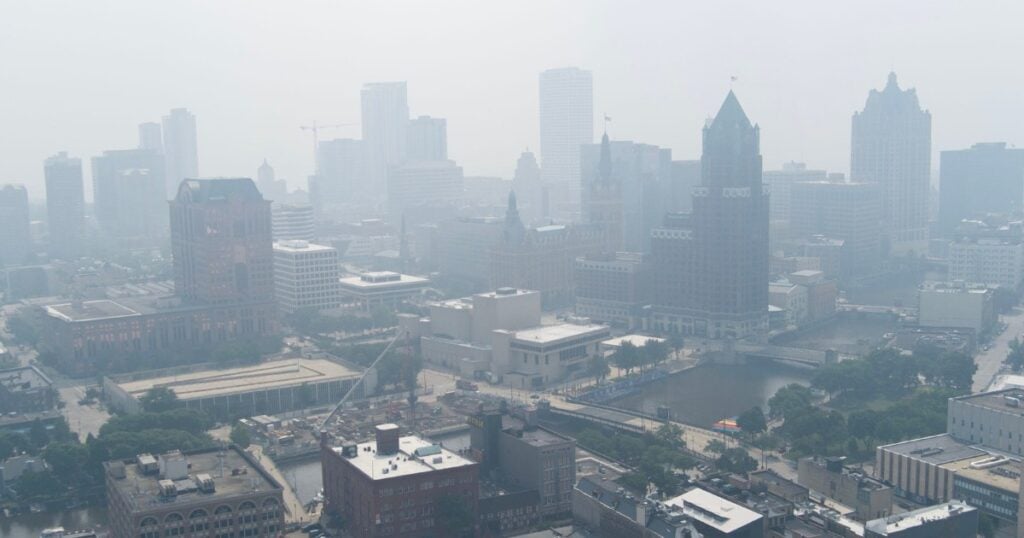Air quality advisory issued for Sunday due to Canadian wildfire smoke – Syracuse.com

Air Quality Advisory Report: Impacts on Public Health and Sustainable Development Goals in New York State
Executive Summary
The New York State Department of Environmental Conservation (DEC) has issued an air quality health advisory for Sunday, prompted by smoke from Canadian wildfires. This event directly impacts several United Nations Sustainable Development Goals (SDGs), particularly those concerning health, sustainable communities, and climate action. The advisory warns of elevated levels of fine particulate matter (PM2.5), which poses significant health risks and disrupts community life.
Impact on Sustainable Development Goal 3: Good Health and Well-being
The primary concern of the air quality advisory aligns with SDG 3, which aims to ensure healthy lives and promote well-being for all at all ages. The influx of fine particulate matter from wildfire smoke presents a direct threat to public health.
- Health Risks: Exposure to PM2.5, which consists of microscopic particles 2.5 microns or smaller, can cause immediate health effects. These include eye, nose, and throat irritation, coughing, sneezing, and shortness of breath.
- Vulnerable Populations: The advisory highlights the disproportionate impact on vulnerable groups, a key consideration for SDG 3. Children, older adults, and individuals with pre-existing respiratory or heart conditions are at heightened risk of severe reactions.
- Preventative Health Measures: In line with promoting well-being, health officials recommend minimizing outdoor activities and avoiding strenuous exercise to mitigate exposure and protect public health.
Implications for SDG 11 (Sustainable Cities and Communities) and SDG 13 (Climate Action)
This environmental event underscores the interconnectedness of air quality, urban living, and global climate patterns, which are central to SDG 11 and SDG 13.
- Sustainable Communities (SDG 11): Safe and resilient communities depend on clean air. The advisory, which forces residents indoors and curtails daily activities, demonstrates how environmental degradation can impact the sustainability and quality of life in urban and rural areas.
- Climate Action (SDG 13): The increasing frequency and intensity of wildfires are widely linked to climate change. The transboundary nature of the smoke serves as a powerful reminder that climate-related events have far-reaching consequences, necessitating urgent and cooperative climate action on a global scale.
Affected Regions and Connection to SDG 15: Life on Land
The advisory specifies several regions within New York State. The root cause of the smoke—wildfires—is a critical issue addressed by SDG 15 (Life on Land), which focuses on protecting and restoring terrestrial ecosystems.
- Western New York: Including Cattaraugus, Chautauqua, Erie, Genesee, Niagara, Orleans, and Wyoming counties.
- Eastern Lake Ontario: Including Northern Cayuga, Jefferson, Monroe, Oswego, and Wayne counties.
- Adirondacks: Including Clinton, Essex, Franklin, Hamilton, northern Herkimer, Lewis, St. Lawrence, and Warren counties.
The degradation of forest ecosystems due to wildfires not only destroys habitats but also releases massive amounts of pollutants into the atmosphere, affecting human and environmental health hundreds of miles away.
1. Which SDGs are addressed or connected to the issues highlighted in the article?
The article on the air quality health advisory due to Canadian wildfires touches upon several Sustainable Development Goals (SDGs). The primary connections are to health, sustainable communities, climate action, and terrestrial ecosystems.
-
SDG 3: Good Health and Well-being
This is the most directly addressed SDG. The article’s core focus is the health impact of air pollution. It explicitly states that the Department of Environmental Conservation (DEC) issued an “air quality health advisory” because of the risks posed by fine particulate matter. It details the potential health effects, such as “eye, nose and throat irritation, coughing, sneezing, a runny nose, or shortness of breath,” and notes that poor air quality can “aggravate existing conditions like asthma or heart disease.” The advisory also identifies vulnerable groups, including “Children, older adults and people with respiratory or heart conditions,” which aligns with SDG 3’s commitment to ensuring healthy lives for all at all ages.
-
SDG 11: Sustainable Cities and Communities
The article discusses an environmental problem directly affecting the quality of life in multiple regions and counties, including Western New York and the Adirondacks. The issuance of an advisory for these populated areas relates to making human settlements safe and resilient. The problem of air pollution from “fine particulate matter” is a key challenge for urban and regional environmental quality, which is a central theme of SDG 11.
-
SDG 13: Climate Action
While not explicitly mentioned, the “Canadian wildfires” are a type of climate-related natural disaster whose frequency and intensity are often linked to climate change. The article discusses a direct consequence of this hazard—cross-border smoke pollution. The state’s response, an “air quality health advisory,” represents a measure to strengthen resilience and adaptive capacity to climate-related hazards, which is a key aspect of SDG 13.
-
SDG 15: Life on Land
The source of the pollution is “Canadian wildfires.” Wildfires are a major threat to forests and biodiversity, leading to land degradation and the destruction of terrestrial ecosystems. Although the article focuses on the human health impact of the smoke, the underlying cause is directly related to the protection and restoration of forests, a core component of SDG 15.
2. What specific targets under those SDGs can be identified based on the article’s content?
Based on the issues discussed, several specific SDG targets can be identified:
-
Target 3.9: Substantially reduce deaths and illnesses from pollution
This target aims to “substantially reduce the number of deaths and illnesses from hazardous chemicals and air, water and soil pollution and contamination.” The article is entirely focused on the health risks from air pollution caused by “fine particulate matter.” The health advisory is a direct attempt to mitigate illnesses by warning the public about hazardous air quality and recommending actions like “minimizing outdoor activities.”
-
Target 3.d: Strengthen early warning and risk reduction for health
This target focuses on strengthening “the capacity of all countries… for early warning, risk reduction and management of national and global health risks.” The issuance of an “air quality health advisory” by a state agency (DEC) is a perfect example of an early warning system in action. It informs the public about an impending health risk (poor air quality) and provides guidance to reduce exposure and potential harm.
-
Target 11.6: Reduce the environmental impact of cities
This target aims to “reduce the adverse per capita environmental impact of cities, including by paying special attention to air quality.” The article highlights a significant air quality issue affecting multiple counties and regions in New York. The advisory itself is a response to a failure to maintain good air quality, thereby drawing attention to this specific aspect of urban and community environmental health.
-
Target 13.1: Strengthen resilience to climate-related disasters
This target is to “strengthen resilience and adaptive capacity to climate-related hazards and natural disasters in all countries.” The wildfires are a climate-related hazard with transboundary impacts. The advisory system is a form of adaptive capacity, helping the population build resilience by taking protective measures against the effects of such disasters.
3. Are there any indicators mentioned or implied in the article that can be used to measure progress towards the identified targets?
Yes, the article mentions or strongly implies several indicators used to track progress on these targets:
-
Indicator 11.6.2: Annual mean levels of fine particulate matter (e.g. PM2.5)
This is the most explicit indicator mentioned. The article states that the smoke is expected to bring “elevated levels of fine particulate matter” and defines it as “microscopic solid particles or liquid droplets in the air that are 2.5 microns or smaller in diameter.” This is a direct reference to PM2.5, which is the exact substance measured by this indicator to assess urban air quality. The entire advisory is based on the measurement or forecast of these levels exceeding a healthy threshold.
-
Indicator 3.9.1: Mortality rate attributed to household and ambient air pollution
While the article does not provide mortality data, it describes the morbidity (illness) associated with air pollution. It lists short-term health effects (“irritation, coughing, sneezing”) and the aggravation of serious conditions (“asthma or heart disease”). These health outcomes are the basis for calculating the mortality and morbidity rates that this indicator tracks. The presence of the pollutant (PM2.5) is the direct cause measured by this indicator.
-
Indicator 3.d.1: International Health Regulations (IHR) capacity and health emergency preparedness
This indicator is implied through the actions described in the article. The fact that the “state Department of Environmental Conservation has issued an air quality health advisory” demonstrates a functioning system for monitoring environmental health risks and communicating them to the public. This is a core component of health emergency preparedness and shows capacity for early warning and risk reduction, which this indicator aims to measure.
4. Table of SDGs, Targets, and Indicators
| SDGs | Targets | Indicators |
|---|---|---|
| SDG 3: Good Health and Well-being | 3.9: By 2030, substantially reduce the number of deaths and illnesses from hazardous chemicals and air, water and soil pollution and contamination. | 3.9.1: Mortality rate attributed to household and ambient air pollution. (Implied by the discussion of health effects from air pollution). |
| 3.d: Strengthen the capacity of all countries… for early warning, risk reduction and management of national and global health risks. | 3.d.1: International Health Regulations (IHR) capacity and health emergency preparedness. (Implied by the issuance of a formal health advisory by a state agency). | |
| SDG 11: Sustainable Cities and Communities | 11.6: By 2030, reduce the adverse per capita environmental impact of cities, including by paying special attention to air quality… | 11.6.2: Annual mean levels of fine particulate matter (e.g. PM2.5 and PM10) in cities. (Explicitly mentioned as “fine particulate matter… 2.5 microns or smaller”). |
| SDG 13: Climate Action | 13.1: Strengthen resilience and adaptive capacity to climate-related hazards and natural disasters in all countries. | Implied Indicator: Existence of local disaster risk reduction strategies. (The advisory system is a form of adaptive strategy to a climate-related hazard). |
Source: syracuse.com

What is Your Reaction?
 Like
0
Like
0
 Dislike
0
Dislike
0
 Love
0
Love
0
 Funny
0
Funny
0
 Angry
0
Angry
0
 Sad
0
Sad
0
 Wow
0
Wow
0



























;Resize=805#)



















































